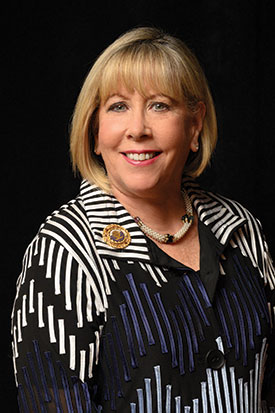Hadassah
President's Column
The Miracles We Make

Hadassah National President
2020 was a year out of time that felt more like a decade. But those of us who have been around long enough to remember chunks of decades can look back and remember when high-tech meant a color television, when American life expectancy was 10 years shorter than today and when quarantine was not an emergency public health measure but a life sentence in a long-ago country called the Soviet Union that kept three million Jews locked in.
This flashback is prompted by events from more than 30 years ago that have enormous relevance today. One week before Hanukkah in 1987, on the eve of a summit between President Ronald Reagan and Premier Mikhail Gorbachev, 250,000 people marched on Washington in solidarity with Soviet Jewry. It was the culmination of a long and successful campaign to pressure the Soviet Union to allow free emigration and, just as importantly, enlist the United States government in putting the issue at the center of bilateral relations.
Israel’s victory in the Six-Day War galvanized Soviet Jewry, and in the 1960s many Jews risked losing their jobs and being imprisoned by applying for exit visas with full knowledge they would be refused. It was also during the 1960s that more Jews from abroad began visiting their Soviet brethren and bringing back news. In 1966, Hadassah National President Charlotte Jacobson led a Hadassah delegation, with participants wearing large Star of David lapel pins so they could be easily identified.
“The Hadassah women were like an army,” said Elie Wiesel, who was in the Moscow at the same time.
After the mission, Hadassah began pushing for the creation of the National Conference on Soviet Jewry, which came to fruition in 1971.
By the time of the 1987 demonstration, the Soviet Jewish emigration movement had achieved more than its founders on either side of the Iron Curtain had dreamed in the 1960s; hundreds of thousands of had been allowed to leave, but emigration was still far from free. It was a little more than a year after the mass march that Gorbachev lifted all restrictions.
That’s when the real work began. Between 1989 and 2006, 1.6 million Jews left the former Soviet Union, two-thirds of them moving to Israel. Like every mass migration, it wasn’t easy at first. Some of the newcomers started out in tent camps; during 1991, several thousand arrived as Saddam Hussein’s missiles were falling on Tel Aviv, near Ben-Gurion Airport. Many highly educated professionals waited years to find work in their fields. The American Israeli writer Yossi Klein Halevi covered the influx as a young reporter and recalls a prominent organist who divided his time between concert tours in Europe and working as a garbageman in Carmiel.
Writing recently in Mosaic Magazine, Matti Friedman observed that the mass immigration “in the space of a few years is one of the biggest demographic dramas in Jewish history… There are essays to be written about how Russian nurses and doctors became the backbone of [Israel’s] health system, or how Russian engineers helped fuel the tech boom, or what the addition of a million productive citizens has been for our economy and strategic position in the Middle East.”
Today, one in four professors in Israeli higher education is a native Russian speaker—and the figure is higher in the scientific fields.
And just as Hadassah played a key role in the emigration campaign, the Hadassah Medical Organization has been enriched by the addition of many Russian-speaking doctors and nurses—not to mention Russian-speaking patients.
Hanukkah gives us light in a season of darkness and reminds us of the miracles we make—ancient and recent—by taking action. May the holiday continue to illuminate our way forward. May 2021 be a year of health and prosperity that feels exactly—no more, no less—like 365 days.










 Facebook
Facebook Instagram
Instagram Twitter
Twitter
Ilene Schneider says
What a wonderfully informative summary of an amazing period of Russian history and how they succeeded in becoming productive and successful Israeli citizens. Thanks to the determination of American Jews, a pro-active President and courageous Russian Jews, Israel’s hospitals and economy have prospered and thousands of Russian Jews have been able to live free and with dignity.